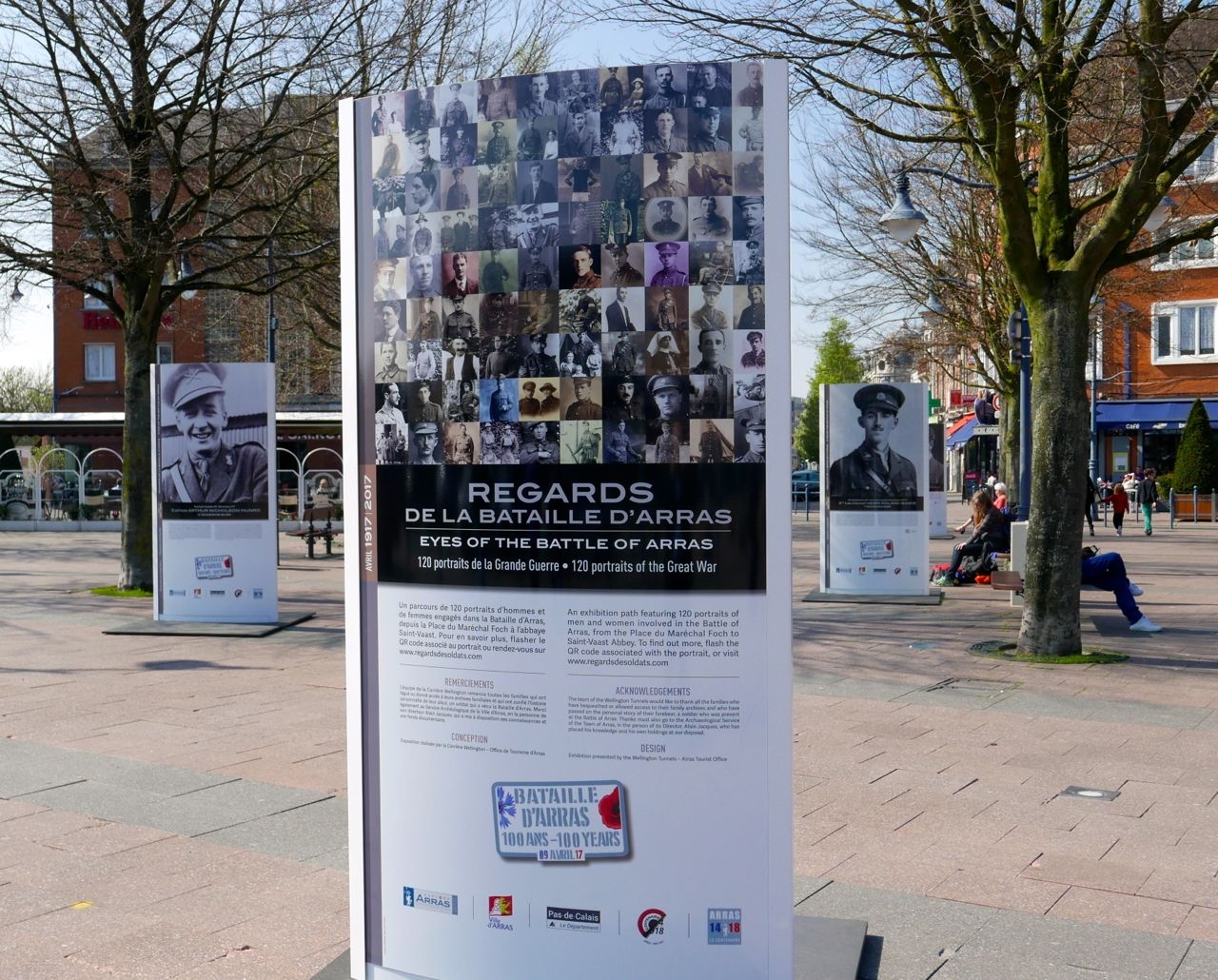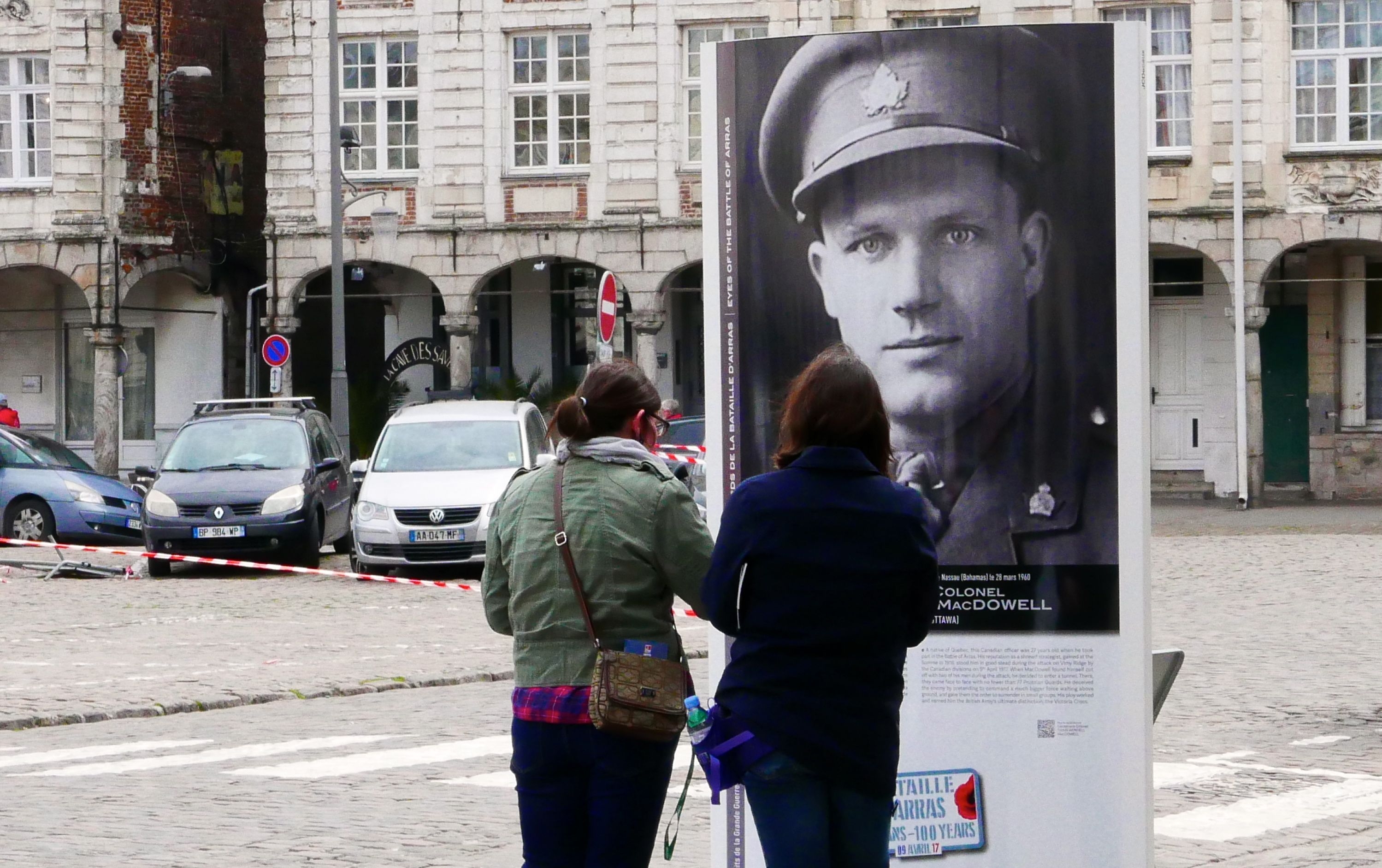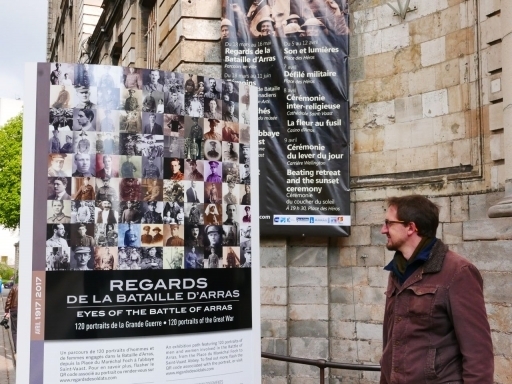A display of pictures lining the streets of Arras for the 2017 Centenary brings visitors up close to the stories of soldiers and many others who served here during the First World War. CN Editor Peter Alhadeff peers into the ‘Eyes of the Battle of Arras’.
They feature the immediately recognisable – King George V and the German air ace, Manfred von Richthofen – and another leading royal figure of the day, King Albert I of Belgium, who toured the battlefields in May 1917 with the British commander, General Sir Edmund Allenby, as the fighting drew to an end.
Richthofen’s decorated Canadian adversary, Captain Billy Bishop VC, is close by. But most are individuals out of the public eye who came to the Arras region to do their duty with the British, Australian, Canadian, New Zealand, French and German forces.
Some of those pictured may surprise, such as Sergeant Masumi Matsui of the 10th Canadian Infantry Battalion. The grandson of a Samurai, he’d emigrated to Canada in 1908. He took command of the battalion’s 35 Japanese fighters, and was awarded the Military Medal for his valour. But to Matsui’s disgust, he and fellow Japanese-Canadians later faced internment as ‘enemy aliens’ during the Second World War.
Nearby is a haunting photo of Russian prisoners-of-war, brought to Northern France by the German Army to build its heavily fortified Hindenburg Line in 1916/17.
There’s also a member of the Chinese Labour Corps, representing the unit hired by Britain to carry out labouring duties on the Western Front. The centenary of the first Chinese workers arriving to support the British war effort is approaching on 19 April 2017. France also recruited tens of thousands Chinese labourers.

A first glimpse of the ‘Eyes of the Battle of Arras’ for travellers arriving at the city’s railway station in Place du Maréchal Foch (Centenary News)
Arras stood on the front line for much of the Great War. Close to the Musée des beaux-arts is a picture of a French soldier and painter, Lieutenant Fernand Sabatté, who was given the task of moving the city’s art treasures to safety. He was awarded the Croix de Guerre and membership of the Légion d’honneur.
Some men, such as German soldier Josef Wojtczak, settled in France after the Great War. A miner of Polish origin, he returned after his release from a prisoner-of-war camp in Britain and worked in the coal mines of the Nord/Pas-de-Calais region, spending the rest of his life in France.
There’s Private Henry Dent, a British Army veteran who enlisted for a third time in August 1914. At 45, he was too old to be sent into battle. Joining the veterinary unit of the 1st Cavalry Division, he nevertheless took part in key battles, including Arras. During the Second World War, Henry Dent served for the last time, becoming an air raid warden.
Most of those pictured are men, but nursing sister Laura James looks across to the Hôtel de Ville (town hall), a building she saw ‘reduced to a vast stone heap’. The New Zealander stayed with her patients during one particularly heavy German bombardment, and was decorated with the Military Medal for her actions.
Families
The display of 120 pictures is a centenary project conceived by Carrière Wellington, the Battle of Arras memorial museum opened in 2008 at the site of the tunnels dug to garrison thousands of Allied soldiers. Photos, letters and other biographical information contributed over the past decade by the families of those who fought provided a rich resource.
Pascal Loosfelt, who spent more than a year organising the event, says the aim is to present the broadest possible view of those who served at the front 100 years ago: “We tried to describe all the functions of army life – infantrymen, machine-gunners and pilots; also the soldiers who served behind the front, in the villages, providing logistics, transporting ammunition and so on.”
Where there’s tangible evidence of a link, the pictures have been sited in neighbourhoods of Arras associated with a soldier’s service or his unit, setting individuals’ stories in the very streets they would have known.
 The story of Lieutenant-Colonel Thain MacDowell, a Canadian officer who won the Victoria Cross for his actions at Vimy Ridge, catches attention in the Grand Place (Photo: Centenary News)
The story of Lieutenant-Colonel Thain MacDowell, a Canadian officer who won the Victoria Cross for his actions at Vimy Ridge, catches attention in the Grand Place (Photo: Centenary News)
‘Eyes of the Battle of Arras’ is on display in Arras until the end of the Battle of Arras Centenary commemorations in mid-May 2017. Full details of all 120 pictures can be found on the Regards de la Bataille d’Arras website. The gallery will still be available to view online after the street exhibition closes.
Visit the official Arras 14-18 website for information about the Arras Centenary programme.
Also in Centenary News:
Read a Battle of Arras summary.
New memorial to NZ tunnellers unveiled at Carrière Wellington dawn ceremony.
Scotland remembers its Battle of Arras soldiers at Faubourg d’Amiens Cemetery.
Fields of Battle Through Canadian Eyes – Canadian First World War touring art exhibition in Arras.
Canadians in the Great War – exhibitions in the Béthune-Bruay region, Artois.
Posted by CN Editor Peter Alhadeff, reporting from Arras
Images: Centenary News
